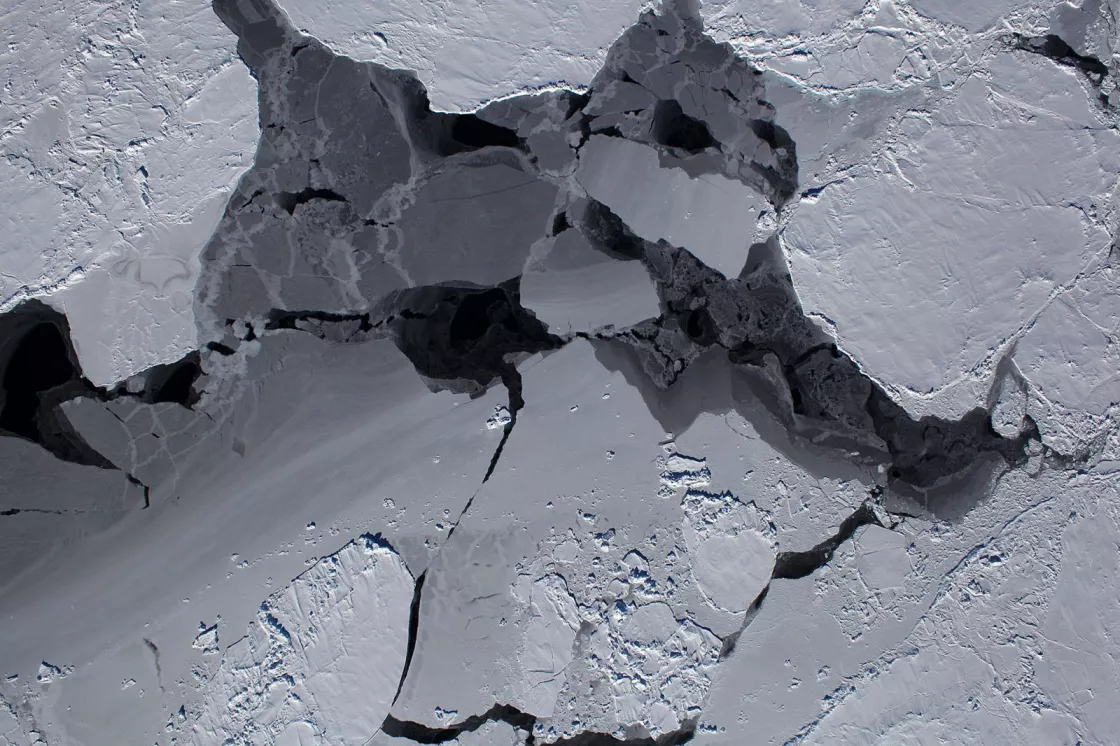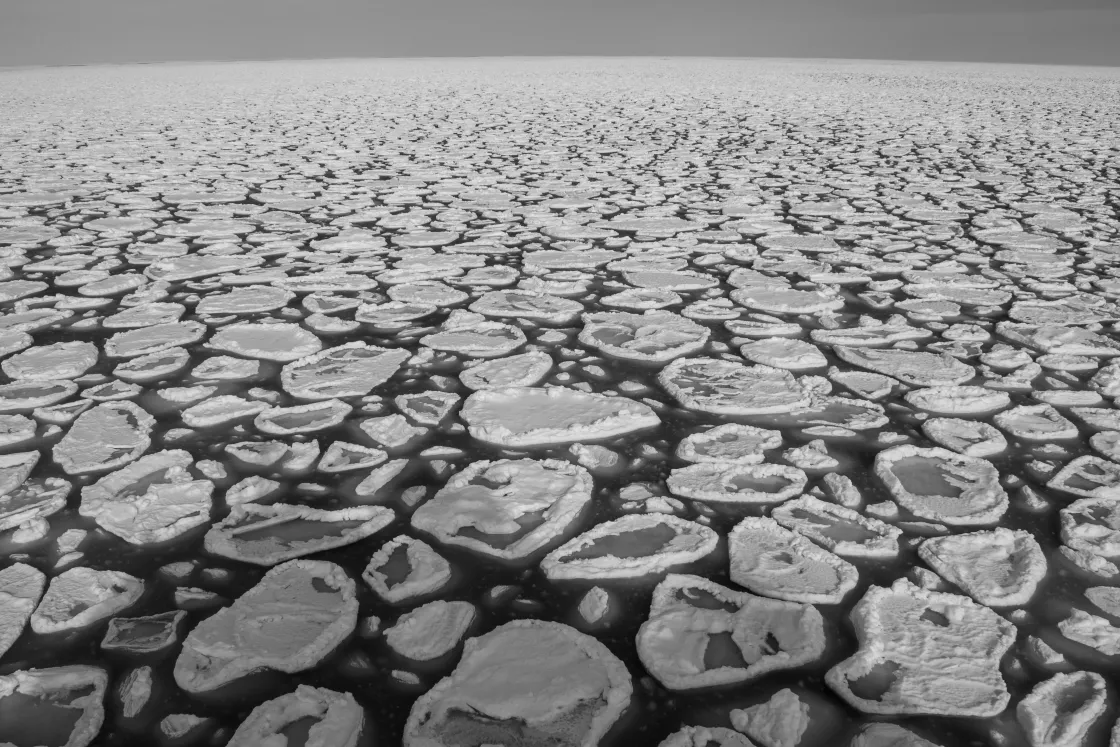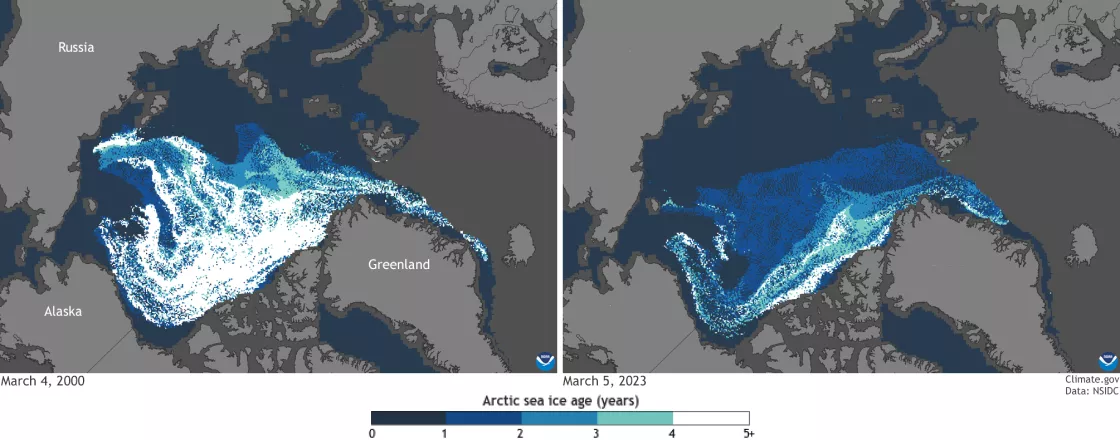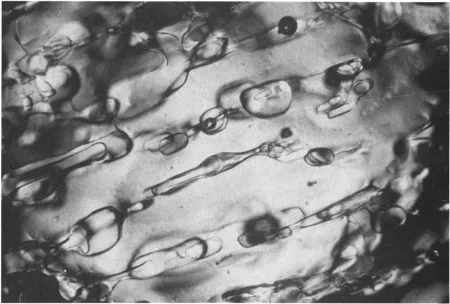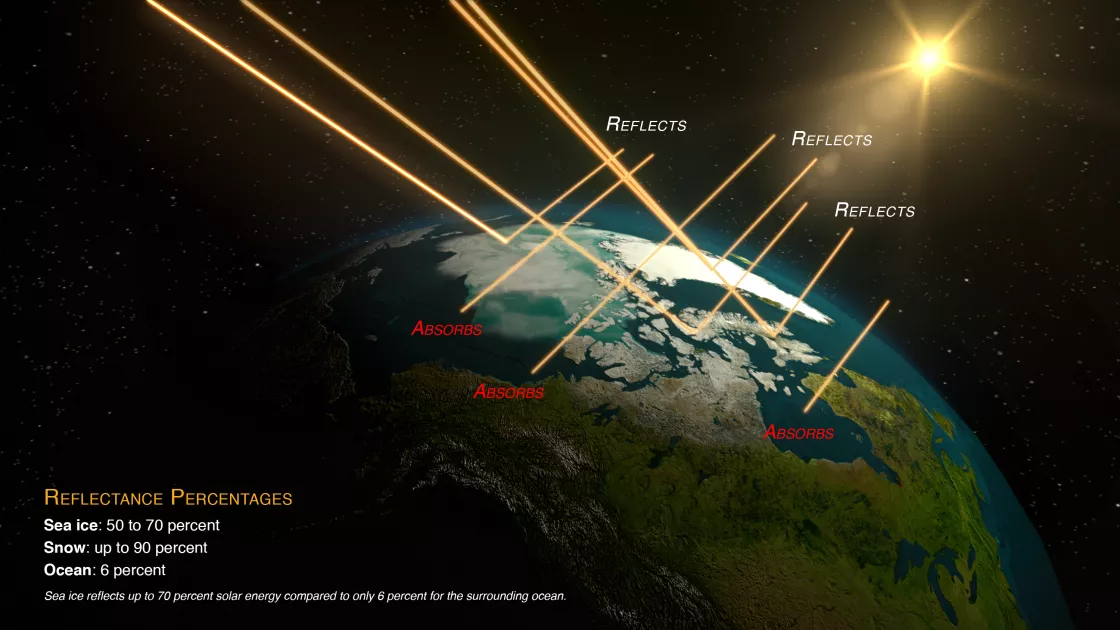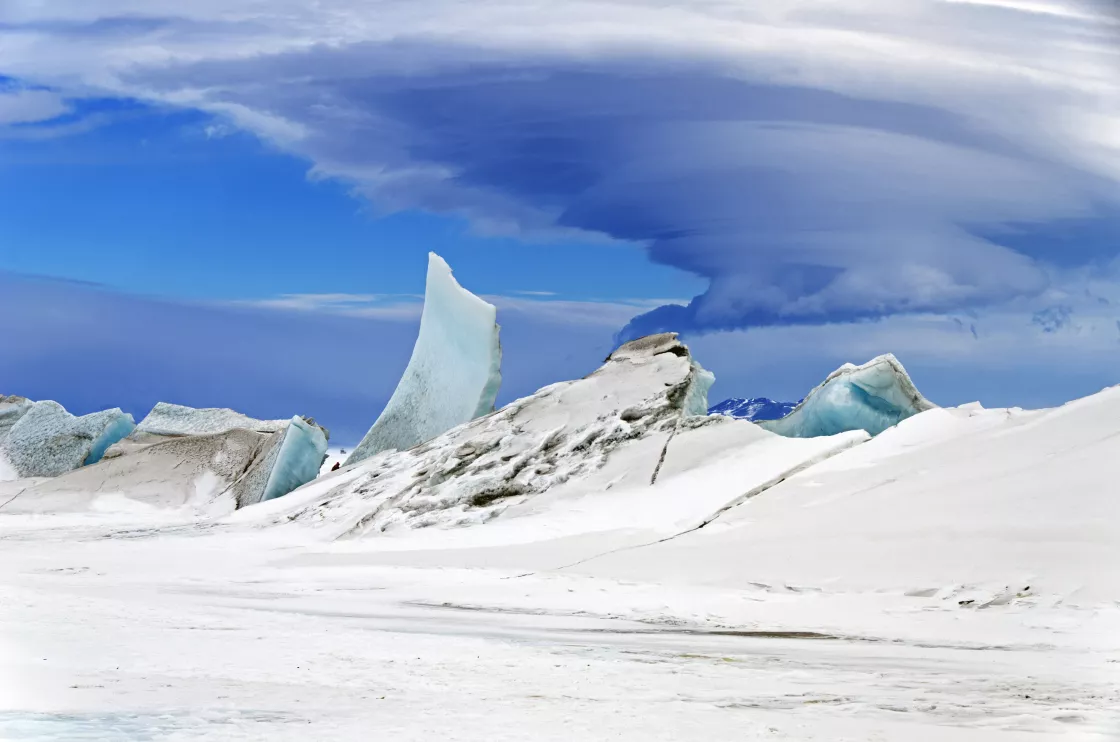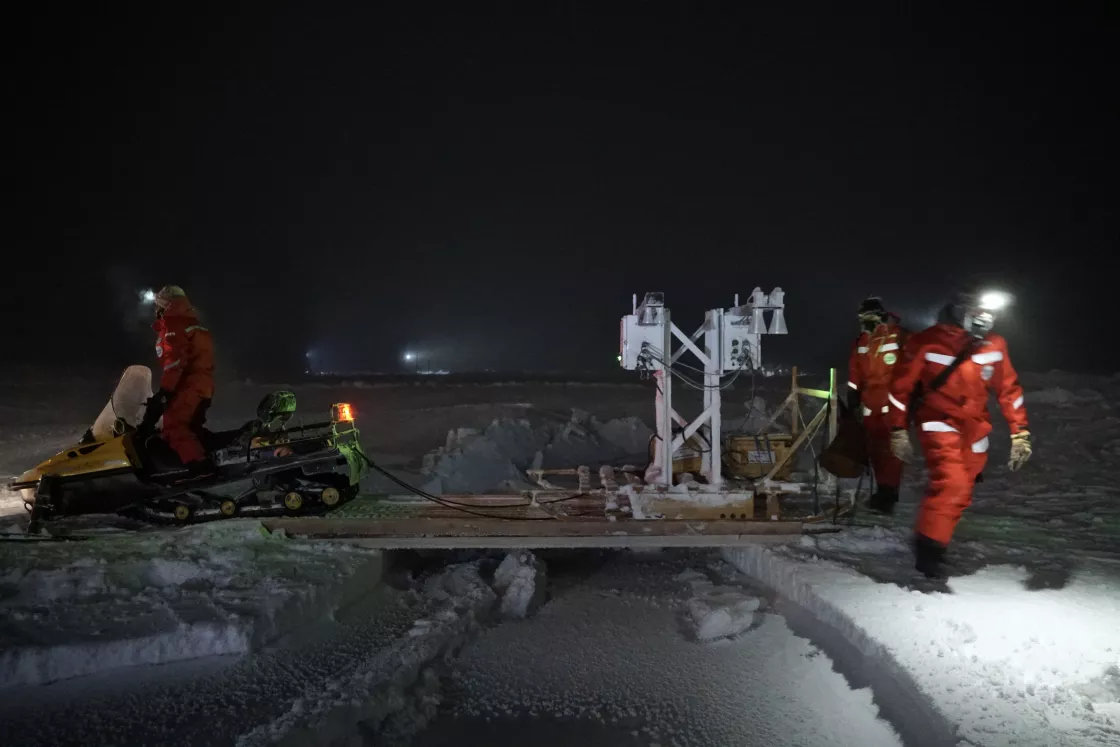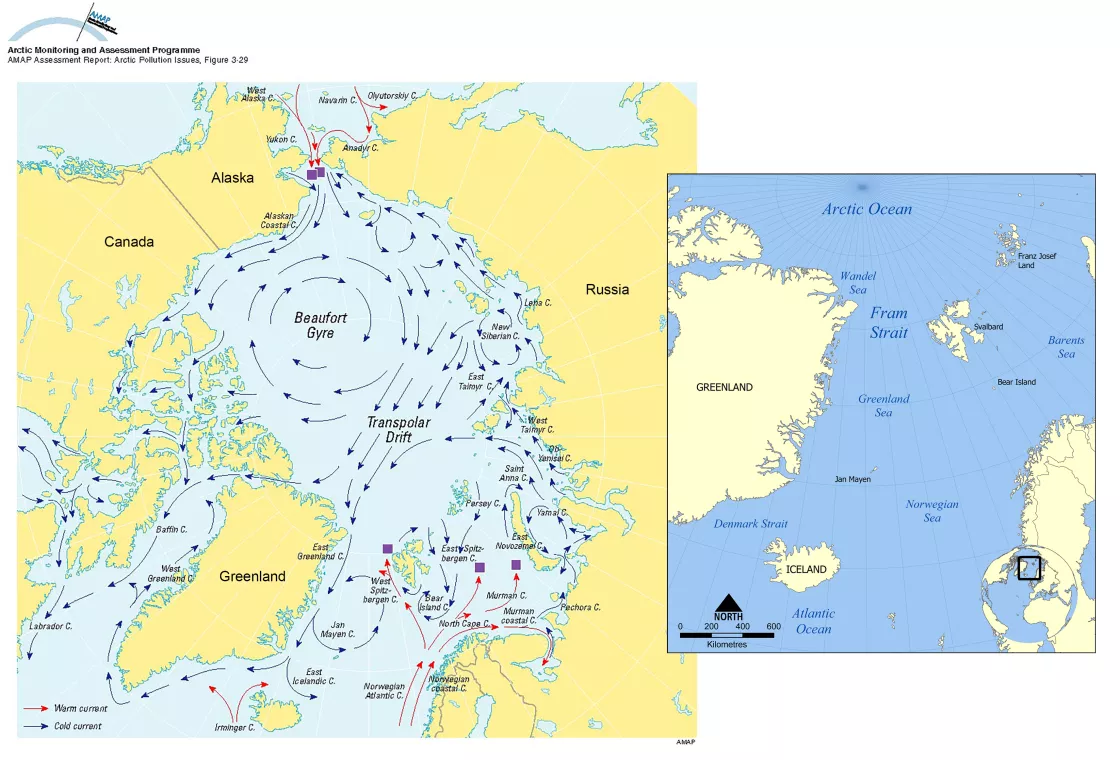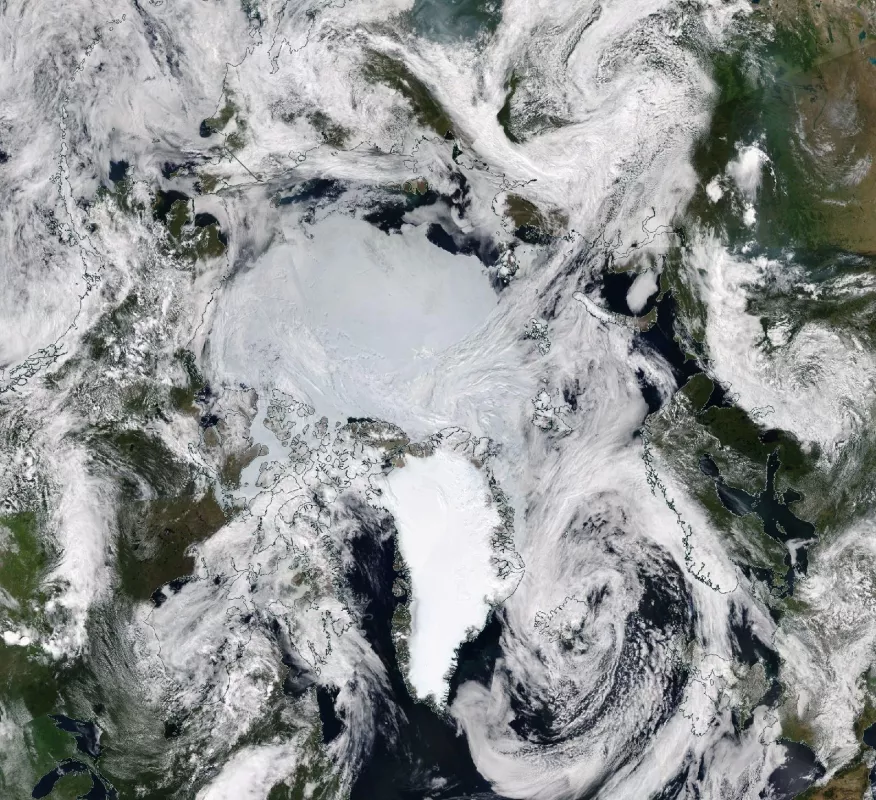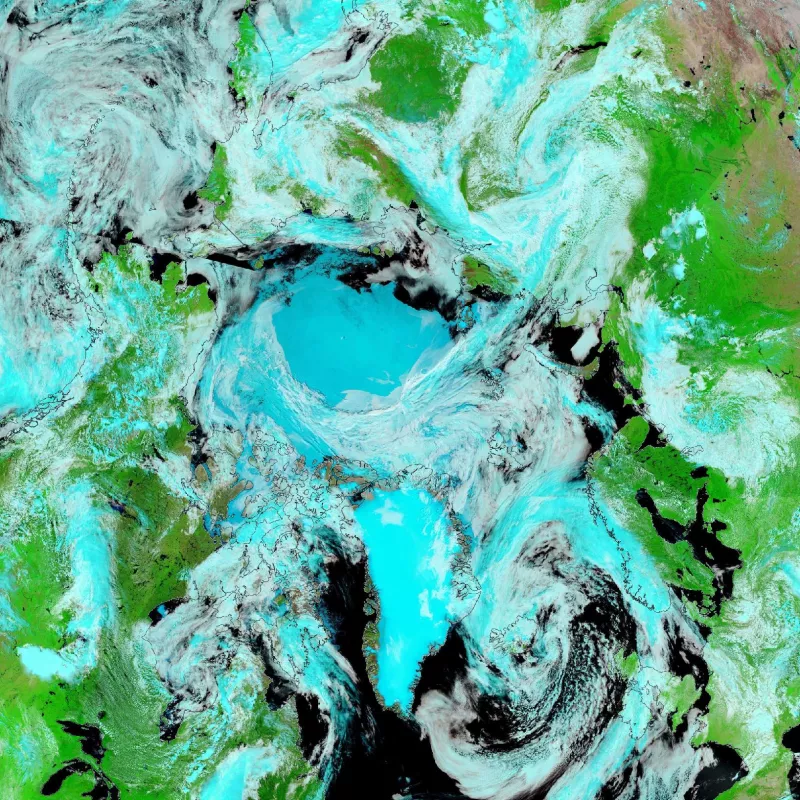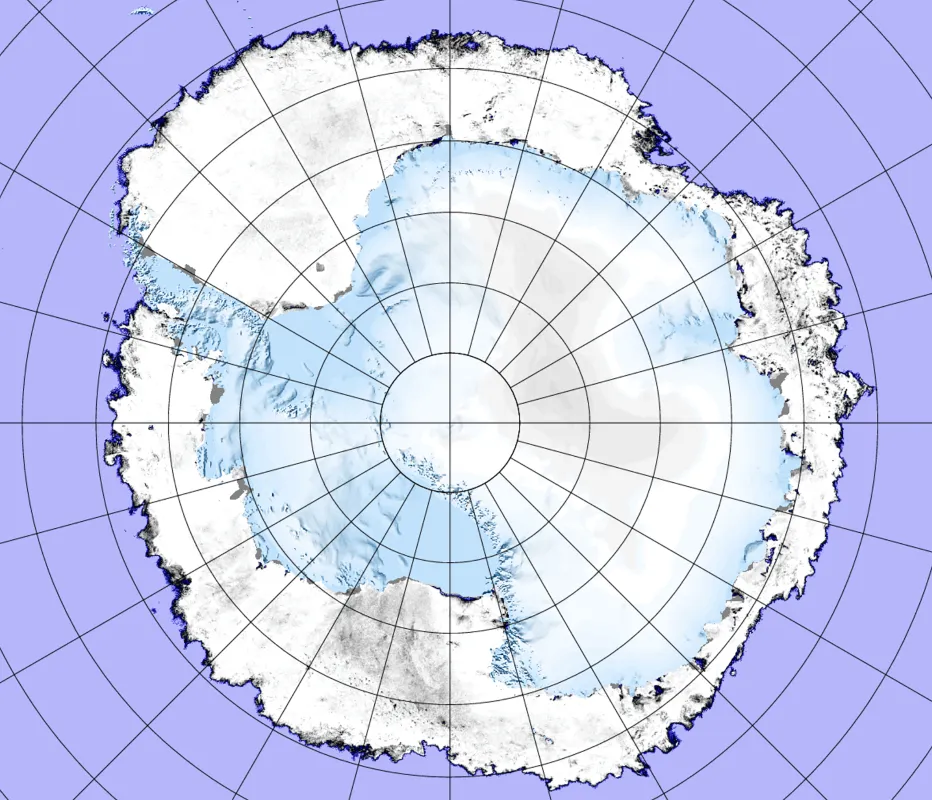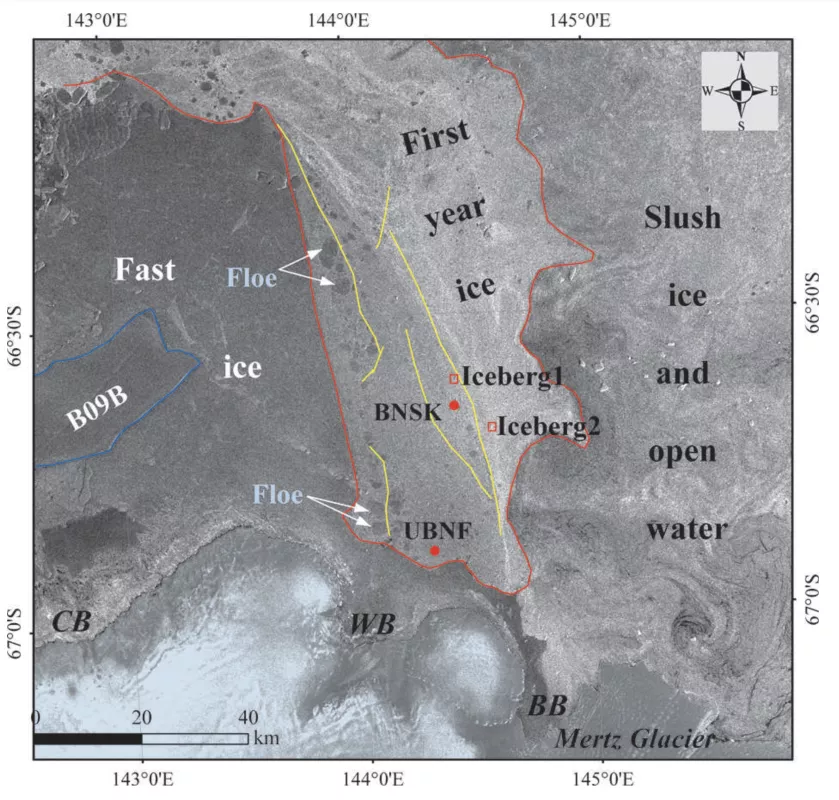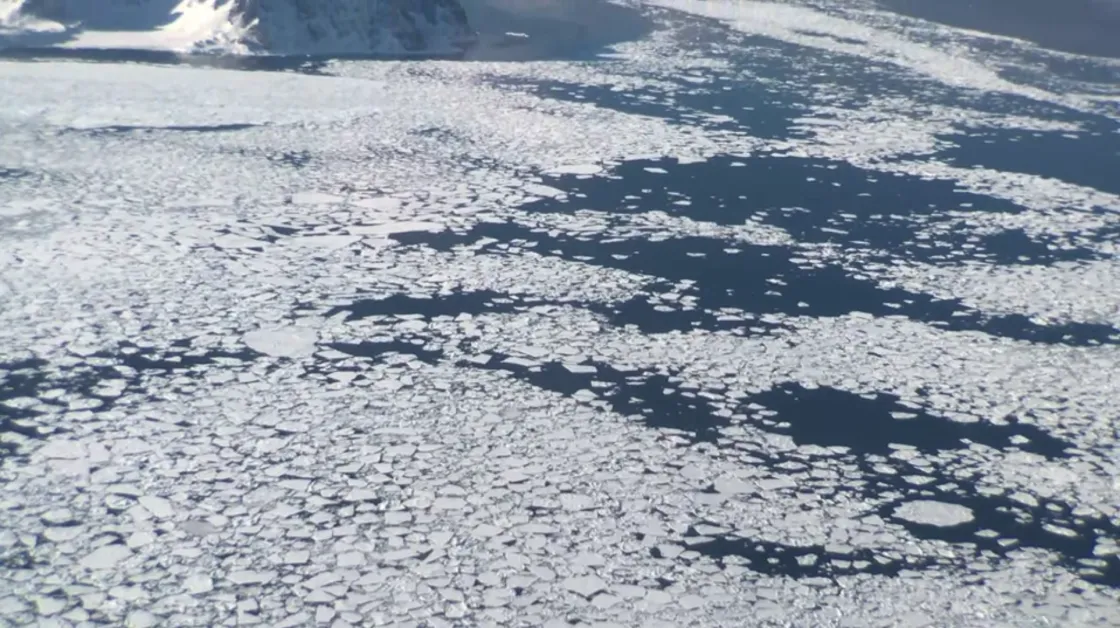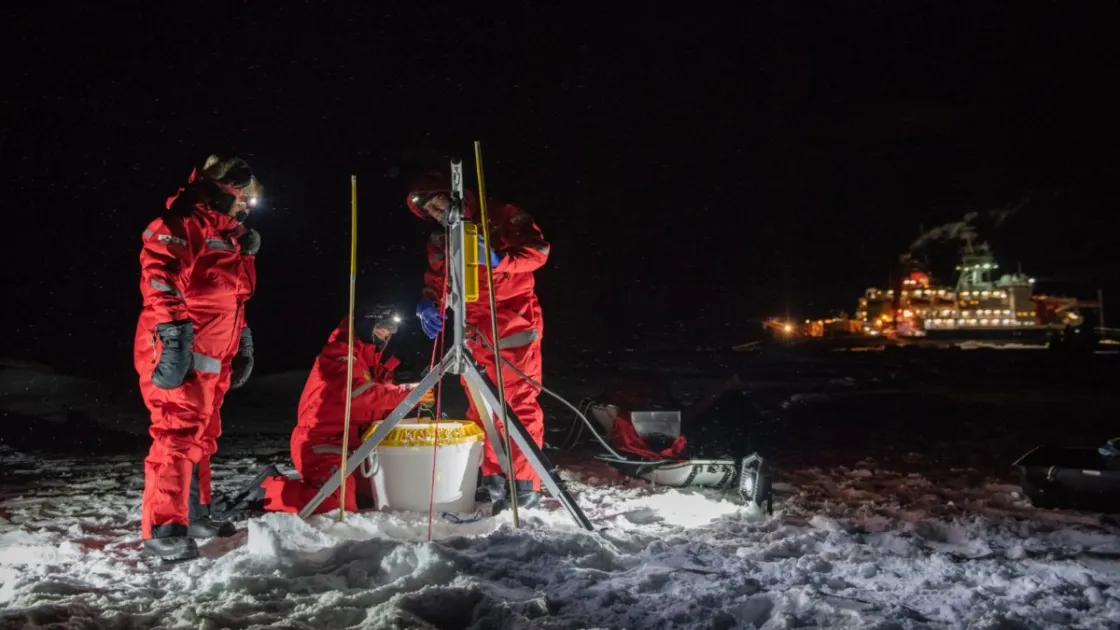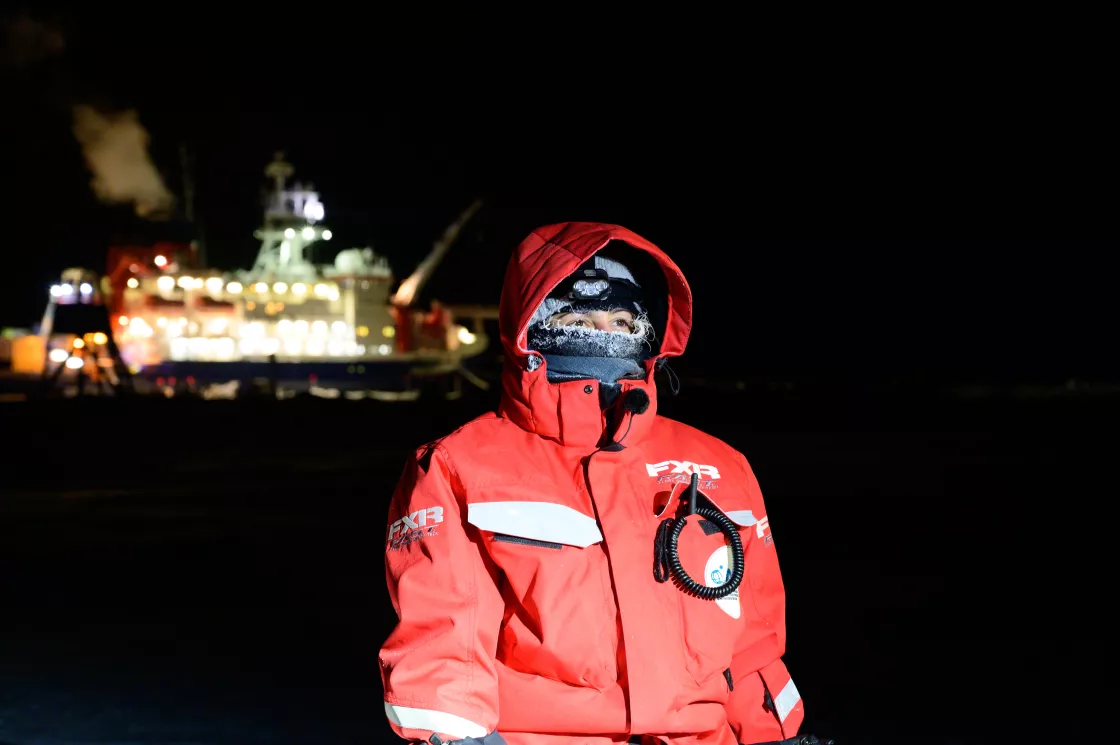Sea Ice
Science
Sea ice is classified by stages of development that relate to thickness and age. A simple classification categorizes sea ice into two primary age groups: first-year or multiyear. First-year ice has existed only since the end of the previous summer melt season; multiyear ice has survived at least one summer melt season. However, for some applications more detailed classification is used, such as for navigational purposes, where finer detail on the age and thickness of the sea ice is needed.
The World Meteorological Organization (WMO) has defined the following categories:
- New ice is a technical term that refers to ice less than 10 centimeters (3.9 inches) thick.
- As the ice thickens, it enters the young ice stage, defined as ice that is 10 to 30 centimeters (3.9 to 11.8 inches) thick. Young ice is sometimes split into two subcategories, based on color:
- gray ice (10 to 15 centimeters, or 3.9 to 5.9 inches thick)
- gray-white ice (15 to 30 centimeters, or 5.9 to 11.8 inches thick)
- First-year ice is thicker than 30 centimeters (11.8 inches), but has not survived a summer melt season.
- Multiyear ice is ice that has survived a summer melt season and is much thicker than younger ice, typically ranging from 2 to 4 meters (78.7 to 157.5 inches) thick.
How sea ice forms
Sea ice forms, grows, and melts in salty ocean water. This sets it apart from other forms of ice like icebergs, glaciers, and lake and river ice. Icebergs and glaciers form from snow falling on land. Lake and river ice from fresh water. Lake ice tends to freeze as a smooth layer, while sea ice develops into various shapes because of the constant turbulence of ocean water.
Sea ice forms more slowly than freshwater ice for two main reasons. First, the freezing temperature of salt water is lower than freshwater; ocean temperatures must reach -1.8°C (28.8°F) to freeze. Secondly, in contrast to fresh water, the salt in ocean water causes the density of the water to increase as it nears the freezing point. As a result, salt water sinks away from the surface before it cools enough to freeze. Generally, the top 100 to 150 meters (300 to 450 feet) of water must cool to the freezing point for sea ice to form. Furthermore, other factors cause sea ice formation to be a slow process.
Stages of ice formation
As the ocean water begins to freeze, small needle-like ice crystals called frazil form. These crystals are typically 3 to 4 millimeters (0.12 to 0.16 inches) in diameter. Because salt doesn't freeze, the crystals expel salt into the water, and frazil crystals consist of nearly pure fresh water. Sheets of sea ice form when frazil crystals float to the surface, accumulate and bond together. This process often expels some very salty water in “brine pockets,” described in more detail below.
In calm waters, frazil crystals form smooth, thin ice, called grease ice for its resemblance to an oil slick. Grease ice develops into a continuous, thin sheet of ice called nilas. Initially, the sheet is very thin and dark (called dark nilas), becoming lighter as it thickens. Currents or light winds often push the nilas around so that they slide over each other, a process known as rafting. As the ice thickens into a more stable sheet with a smooth bottom surface, frazil ice production ceases in the relatively still waters under the ice. Ice continues growing when crystals grow directly on the bottom of the ice surface. This bottom ice growth is called congelation ice. Congelation ice crystals are long and vertical because they grow much slower than frazil ice.
In rough ocean waters, the frazil crystals accumulate into slushy circular disks, called pancakes or pancake ice, because of their shape. A signature feature of pancake ice is raised edges or ridges on the perimeter, caused by ocean waves bumping the pancakes into each other. If the motion is strong enough, rafting occurs, where thin sheets of ice slide over one another. If the ice is thick enough, ridging occurs, where the sea ice bends or fractures and piles on top of itself, forming ridges on the surface. Each ridge consists of above-the-surface ice, called a sail, and below-the-surface pile of ice, called a keel. Because of the difference in density between the ice and the water, most of the ice in a ridge is below the surface. For instance, keels are about nine times thicker than their corresponding sail. Particularly in the Arctic, ridges up to 20 meters (66 feet) thick can form when thick ice deforms.
Eventually, the pancakes cement together and consolidate into a coherent ice sheet. This formation process results in a rough bottom surface of ice with large undulations. Ice will continue to grow on the bottom via congelation growth, adding thickness to the ice cover.
Once sea ice forms into sheet ice, it continues to grow through the winter as first-year ice. When temperatures increase in spring and summer, the ice begins to melt. If the ice remains thin over the winter or if the spring and summer temperatures are high enough, the ice will melt out completely during the summer. If the ice grows thick enough during the winter and/or it experiences less extreme spring and summer conditions, it will thin during the summer, but it will not melt completely. In this case, it remains until the following winter, when it grows and thickens and is classified as multiyear ice.
Multiyear ice
Multiyear ice has distinct properties that distinguish it from first-year ice, based on processes that occur during the summer melt. A process that distinguishes the two kinds of ice is the flushing of brine pockets that had formed during the initial freeze-up. So, multiyear ice contains much less brine and more air pockets than first-year ice because of processes explained below. Less brine means “stiffer” ice that is more difficult for icebreakers to navigate and break through. It also means that multiyear ice is much fresher, containing very little salt. In fact, multiyear ice often supplies the fresh water needed for polar expeditions.
First-year and multiyear ice have different electromagnetic properties that satellite sensors can detect, allowing scientists to distinguish the two. For more information, see Research below.
Multiyear ice is more common in the Arctic than in the Antarctic. This is because ocean currents and atmospheric circulation move sea ice around Antarctica, causing most of the ice to melt in the summer as it moves into warmer waters, or as the upper ocean heats up because open water areas absorb solar heat. Most of the multiyear ice that does occur in the Antarctic persists because of a circulating current in the Weddell Sea, on the eastern side of the Antarctic Peninsula.
In contrast to Antarctica, the Arctic Ocean is relatively landlocked. Historically, this land-ocean configuration allowed extensive multiyear ice to form. However, multiyear ice has declined significantly in the Arctic. The most complete record of ice age began in 1984. The first substantial drop in multiyear ice occurred from the late 1980s through about 1995. The main cause appears to have been a persistent positive Arctic Oscillation, which set up a general wind circulation pattern that pushed multiyear ice out of the Arctic from the Beaufort Sea region through Fram Strait, east of Greenland.
There was another substantial drop during 2005 to 2007. In 2005, most of the first-year ice melted out completely, so there was very little replenishment of multiyear ice. Then in 2007, the overall ice extent set a new record low. Again, a pattern of ice motion transported a lot of multiyear ice across the Arctic Ocean towards Fram Strait. From 2007 to 2023, multiyear ice has bounced up and down over 1- to 3-year cycles, but remains lower than pre-2005 levels and the overall trend is downward.
Sea ice typically drifts around the Arctic with prevailing winds and ocean currents, and sea ice exits the Arctic Ocean through Fram Strait. As ice thins, its speed increases, transporting more ice through the Strait, which results in more multiyear ice leaving the Arctic Ocean at an increasing rate. The Beaufort Gyre, a circular current north of Alaska, used to act as a nursery for young sea ice where it could persist and thicken over time. Since the start of the twenty-first century, substantial amounts of ice have melted in the southern arm of the gyre, which has decimated the existing multiyear ice and allowed much less first-year ice to survive and transition to new multiyear ice.
Sea ice properties
Salinity and sea ice
Salt and sea ice are an ever-evolving duo. Sea ice loses its salt content over time and, if the ice persists long enough, it loses all its salt. The older the sea ice, the lower its salt concentration. When sea ice forms, it tends to be very salty because it contains concentrated droplets called brine that are trapped in pockets between the ice crystals. As it ages, the brine gets pushed out. Sea ice that is four or more years older is nearly free of brine.
Salinity is a measure of the concentration of dissolved salts in water. A common way to define salinity values had been parts per thousand (ppt), or kilograms of salt in 1,000 kilograms of water. Today, however, salinity is usually described in practical salinity units (PSU), a more accurate but more complex definition. Nonetheless, values of salinity in ppt and PSU are nearly equivalent. The average salinity of the ocean typically varies from 32 to 37 PSU, but in polar regions, it may be less than 30 PSU. Sodium chloride (table salt) is the most abundant of the many salts found in the ocean.
Fresh water freezes at 0°C (32°F), but the freezing point of seawater varies. For every 5 PSU increase in salinity, the freezing point decreases by 0.28°C (0.5°F); thus, in polar regions with an ocean salinity of about 32 PSU, the water begins to freeze at -1.8°C (28.8°F). The Arctic Ocean is generally fresher than other oceans, somewhere between 30 and 34 PSU, but salinity levels vary by region, and areas with strong river inflow may have even lower salinity.
Pushing brine out of sea ice
- When needle-like ice crystals called frazil form, highly saline water accumulates into droplets called brine, which are typically expelled back into the ocean. Salinity of near-surface water then rises.
- Some brine droplets become trapped in pockets between the ice crystals. These droplets are saline, whereas the ice around them is not. The brine remains in a liquid state because much cooler temperatures would be required for it to freeze. At this stage, the sea ice has a high salt content.
- Over time, the brine drains out, leaving air pockets, and the salinity of the sea ice decreases. Brine can move out of sea ice in different ways:
- Aided by gravity, the brine migrates downward through holes and channels in the ice, eventually emptying back into the ocean.
- The ice surrounding the brine compresses and breaks the brine pockets, allowing the brine to escape to the ocean.
- When the sea ice begins to melt during the summer, small freshwater ponds called melt ponds form on the surface. This freshwater travels through the cracks and holes in the ice, washing out remaining brine.
- When the sea ice surface cools, brine increases in salinity to the point at which it can melt ice at its underside. This leads to a downward migration of brine droplets, ultimately allowing the brine to escape into the ocean below the ice sheet.
Salt & ocean circulation
Salt plays an important role in ocean circulation. In cold, polar regions, changes in salinity affect ocean density more than changes in temperature. When salt is ejected into the ocean as sea ice forms, the water's salinity increases. Because salt water is heavier, the density of the water increases and the water sinks. The exchange of salt between sea ice and the ocean influences ocean circulation across hundreds of kilometers. Learn more about how sea ice affects ocean circulation.
Snow on sea ice
Snow typically covers sea ice and insulates it. The insulation slows ice growth in the winter but also delays melting in the summer. The snow also modifies the electromagnetic radiation signal detected by satellites. Except during a melt season, the snow is usually dry, wind-blown, and hard-packed. Wind from a consistent direction can blow snow into ridges parallel to the wind direction, just like small sand dunes. These complex, fragile shapes are called sastrugi.
If snow cover is thick, especially over relatively thin sea ice, the weight of the snow can push the ice down into the water below. The salty ocean water floods the snow and creates a salty, slushy layer. This flooded sea ice is more common in the Antarctic than the Arctic because there is typically thinner ice and more snowfall in Antarctica.
During summer, as the snow on top of sea ice melts, the meltwater can accumulate in depressions on the sea ice surface called melt ponds. These ponds absorb more heat than the surrounding sea ice from sunlight, and they grow in area and depth. The fresh water in melt ponds appears blue because light reflects and scatters off the sea ice surface from the bottoms and sides of the melt pond. If a pond melts through the entire thickness of the ice, the pond's color turns dark, like the ocean. Melt ponds are more common in the Arctic than in the Antarctic partly because Arctic ice lasts longer, giving melt ponds more opportunities to form, and because Arctic sea ice more often has an uneven surface, giving melt ponds places to form.
Other features that form on the surface of sea ice are frost flowers, crystals of ice deposited on the sea ice when water vapor bypasses the liquid phase and becomes a solid. Frost flowers roughen the surface and dramatically alter its electromagnetic signal.
Sea ice & albedo
Albedo is a non-dimensional, unitless quantity that indicates how well a surface reflects solar energy. Albedo is measured in values between 0 and 1. Albedo commonly refers to the “whiteness” of a surface, with 0 meaning black and 1 meaning white. A value of 0 means the surface is a “perfect absorber” that absorbs all incoming energy. Absorbed solar energy can be used to heat the surface or, when sea ice is present, melt the surface. A value of 1 means the surface is a “perfect reflector” that reflects all incoming energy.
Albedo generally applies to visible light, although it may involve some of the infrared region of the electromagnetic spectrum. People understand the concept of low albedo intuitively when they avoid walking barefoot on blacktop on a hot summer day. Blacktop has a much lower albedo than concrete, and the black surface absorbs more of the sun’s energy and reflects less energy than the lighter concert.
Sea ice has a much higher albedo compared to many other Earth surfaces, particularly the surrounding ocean. A typical ocean albedo is approximately 0.06, while bare sea ice varies from approximately 0.5 to 0.7. This means that the ocean reflects only 6 percent of the incoming solar radiation and absorbs the rest, while sea ice reflects 50 to 70 percent of the incoming energy. The sea ice absorbs less solar energy and keeps the surface cooler.
Snow has an even higher albedo than sea ice, so thick sea ice covered with snow reflects as much as 90 percent of the incoming solar radiation. This serves to insulate the sea ice, maintaining cold temperatures and delaying ice melt in the summer. After the snow does begin to melt, and because shallow melt ponds have an albedo of approximately 0.4 to 0.5, the surface albedo drops to about 0.75. Albedo drops further as melt ponds grow and deepen.
Sea ice formations
Sea ice is not a continuous, uniformly smooth sheet of ice, but rather a complex surface that varies dramatically across even short distances. Most sea ice features occur when sea ice either converges or spreads out.
Ice floes and ridges
When wind, ocean currents, and other forces push sea ice around, ice floes (sheets of ice floating in the water) collide with each other, and ice piles into ridges and keels. Ridges are small “mountain ranges” that form on top of the ice; keels are the corresponding features on the underside of the ice. The total thickness of the ridges and keels can be several meters (in some cases, 20 meters, or 60 feet, thick), and the surface ridges can easily be 2 meters (6 feet) or higher. Ridges create significant obstacles to anyone trying to traverse the ice.
Ridges are initially blocky with very sharp edges. Over time, especially during the summer melt, the ridges erode into smaller, smoother “hills” of ice called hummocks. This process is similar to the erosion of jagged mountain peaks into smooth, rolling hills, but at an accelerated pace. When keels erode into smooth features, they are called bummocks.
Leads
Leads are narrow, linear cracks in the ice that form when ice floes diverge or shear as they move parallel to each other. The formation of leads is similar to mid-ocean ridges or shear zones that form from Earth's moving tectonic plates. The width of leads varies from a couple of meters to over a kilometer. Leads can often branch or intersect, creating a complex network of linear features in the ice that can extend over hundreds of kilometers.
Leads are important for several reasons. First, seasonal changes influence local and regional climate. Leads are much darker than surrounding ice, which during the summer, results in relatively lower albedo (ability to reflect light). Because of lower reflectivity, leads absorb more solar energy than the surrounding ocean, which heats the water in the leads and speeds up the melting of surrounding ice. In summer, leads may remain open and expand, or they may close if winds and/or ocean currents push the surrounding ice together. Leads forming in winter will generally start to refreeze very quickly, and this refreezing process adds salt to the open ocean layer. While the lead remains open in winter, it releases heat and moisture to the atmosphere. Thus, leads are often accompanied by low-level clouds downwind. As in summer, a wintertime lead may close because winds or ocean currents push the surrounding ice together.
Leads are also important for wildlife. Seals, whales, penguins, and other animals rely on leads for access to oxygen. Polar bears in the Arctic often hunt near leads because they know that their prey is likely to come to the surface to breathe in such areas.
Finally, leads are important for navigation. Even when they freeze, leads tend to contain thinner and weaker ice that allows submarines to more easily surface through the ice and icebreakers to more easily traverse the ice.
Polynyas
Polynyas are areas of persistent open water where we would expect to find sea ice. For the most part, they tend to be roughly oval or circular in shape, but they can be irregularly shaped, too. The water remains open because of processes that prevent sea ice from forming or that quickly move sea ice out of the region. There are two types of polynyas—open-ocean or coastal polynyas—differentiated by the mechanism of ice removal. One process often dominates in a given polynya, but both can occur.
Sensible-heat (open-ocean) polynyas
Sensible-heat transfer occurs between two bodies at different temperatures that are in contact with each other. The body with the higher temperature transports sensible heat to the body with the lower temperature. A sensible-heat polynya forms when water that is above freezing upwells, or moves from the lower depths of the ocean to the surface. Heat transfers from the warmer water to the ice, melting it, and preventing new ice from forming. The topography of the ocean bottom or overturning of water causes the warm water to rise to the surface. In this type of polynya, sensible heat from the ocean provides the source of heat needed to melt the ice. Sensible-heat polynyas usually form in mid-ocean areas, far from coasts or other barriers.
Latent-heat (coastal) polynyas
Latent-heat transfer occurs when matter changes state; latent heat is absorbed when ice melts, and it is released into the surroundings when liquid water freezes. The process is called “latent” because it is not associated with a change in temperature, but rather with a change of state.
A latent-heat polynya is characterized by ocean water at the freezing point. It forms as a result of winds blowing in a persistent direction that push the ice away from a barrier, such as the coast, fast ice (ice that is anchored to the shore or ocean bottom), a grounded iceberg or an ice shelf. As new ice grows within polynyas, wind blows it to the leeward side, while the windward side remains ice-free. Latent heat is released as water freezes and also as water evaporates into the air above the open water. Some sensible-heat exchange also occurs within latent-heat polynyas because the water in the polynya is generally warmer than the air above it, even though the water is at freezing temperature.
When sea ice forms in polynyas or elsewhere, salt is expelled into the water, raising the salinity of the near-surface water. The salt increases the density of the surface water, making the surface water heavier than the water below, causing it to sink. In some cases, the high-density surface water mixes with other masses and sinks all the way to the ocean bottom. Latent-heat polynyas, particularly those in the coastal regions of Antarctica, are a major source of the world's bottom waters, which influence the process of thermohaline circulation. Learn more about why thermohaline circulation matters.
Polynyas are important for various reasons. Like leads, they are a source of heat and moisture to the atmosphere, so they modify the weather in surrounding areas. As discussed above, they are sources of ocean bottom water. Polynyas are also important resources for wildlife. They provide access between the ocean and atmosphere for a variety of animals, including seals and penguins. Because polynyas persist for longer time periods than leads, and because overturning ocean water brings nutrients to the surface, phytoplankton thrive in polynyas. Phytoplankton are microscopic plant-like organisms that form the basis of the marine food chain. During the summer, Antarctic polynyas are one of the most biologically productive regions in the world's oceans. Learn more about how sea ice impacts wildlife.
Similarities and differences between leads and polynyas
Similarities:
- Both are regions of open water where we would expect to find sea ice.
- Both can influence weather and climate in their immediate surroundings.
- Both play important roles in wildlife habitats.
Differences:
- Leads are narrow, linear features, while polynyas are generally more uniform in shape and larger in size.
- Leads form because of the motion of the ice, while polynyas form from either upwelling warm water or persistent winds.
- During winter, open water remains in leads for only a short time before it begins to refreeze, while polynyas usually remain unfrozen for longer periods of time.
How sea ice changes
Processes that affect the growth and melt of sea ice are referred to as thermodynamics. In the simplest sense, when the temperature of the ocean reaches the freezing point for salt water at -1.8°C (28.8°F), ice begins to grow. When the temperature rises above the freezing point, ice begins to melt.
Because of the ocean’s dynamic nature, sea ice does not generally grow and melt in a single place. Instead, most sea ice is constantly moving and changing location. Only in places near the coast, where ice can attach to the coast or shallow shelf region, is it pinned in place and does not move. Such ice is called fast ice because it is fastened to the coast.
The amount and rates of growth and melt depend on the way heat is exchanged within the sea ice, as well as between the top and bottom of the ice. The following sections describe these processes in more detail.
How sea ice thickens
When cold air cools the ocean surface to the freezing point, sea ice begins to form. As the ocean temperature nears the freezing point, the water density increases and the water sinks. Warmer water that replaces it must also be cooled, so more than just the ocean surface needs to reach the freezing point. Once ice begins to grow, it acts as an insulator between the ocean and atmosphere. Heat from the ocean must be conducted, or pass through, the sea ice before being emitted to the atmosphere. Ice growth slows as the ice thickens because it takes longer for the water below the ice to lose its heat through ice to reach the freezing point.
The relationship between thermodynamics and sea ice thickness can be thought of most simply in terms of freezing degree days (FDD), which is essentially a measure of how cold it has been for how long. The cumulative FDD is simply the daily degrees below freezing summed over the total number of days the temperature was below freezing.
The freezing temperature of ocean (saline) water is typically -1.8°C (28.7°F). If the average daily temperature was -5.8°C (21.6°F), this would be -4°C (24.8°F) for one day, as the following equation shows:
(-1.8) — (-5.8) = 4 degrees below freezing
4 degrees below freezing, Day 1 = 4 cumulative FDD
7 degrees below freezing, Day 2 = 11 cumulative FDD
2 degrees above freezing, Day 3 = 9 cumulative FDD
Scientists have developed different formulas to estimate ice thickness from thermodynamic growth, using the FDD. One such formula (from Lebedev 1938) is:
Thickness (cm) = 1.33 * FDD (°C)0.58
The ice thickness increases at a rate roughly proportional to the square root of the cumulative FDD. Formulas such as this are empirical, meaning they were derived only from observed data, so they really are simplifications of the ice growth processes. The formulas assume that the ice growth occurs in calm water and is reasonably consistent, and they do not take into account sea ice motion, snow cover, and other surface conditions.
Snow cover is one factor that dramatically alters the actual sea ice thickness calculated from the above formula. Snow is an effective insulator, slowing the transfer of heat from the ocean, through the ice, and to the atmosphere. Snow essentially slows the growth of ice.
How sea ice melts
Sea ice melts during the summer when solar radiation heats the ice surface. The amount of solar radiation absorbed by the ice depends on surface albedo, a characteristic described in the above section Sea ice & albedo.
Sea ice reflects about half of the incoming solar radiation. This reflection prevents the ice from warming up as quickly as open ocean would, but radiation can nonetheless heat the ice enough to initiate melting. Thick sea ice covered with snow reflects even more radiation, approximately 90 percent. As a result, sea ice with snow takes even longer to melt. After the snow starts to melt, melt ponds may form, and because water has a lower albedo than snow, the surface albedo of sea ice with snow and melt ponds drops. As the melt ponds grow and deepen, the albedo continues to decrease, leading to higher absorption of solar radiation and an increased rate of melting.
Energy to melt ice can come from sources besides direct solar energy. Water that is under the ice and that has a temperature above the freezing point causes the bottom surface of the ice to melt. Warm surface waters cause the edges of the ice to melt, particularly in leads and polynyas. See Sea ice formations above.
Seasonal cycle
Sea ice growth begins during the autumn, when incoming solar energy decreases and air temperatures fall below the freezing point. Ice growth continues through the winter, and the ice becomes thicker as heat continually transfers from the relatively warm ocean to the cold atmosphere. As the sun climbs higher in the sky and solar energy increases in the spring and summer, the temperatures rise and the ice begins to melt. If the ice has not grown thick enough during the autumn and winter, it may melt completely during spring and summer if the conditions are warm enough. However, if the ice grows thick enough during the growth season and conditions are relatively cool through the summer, it will thin slightly through the melt season, and thicken again the following autumn. Such ice may remain for several years, thinning during the summer and regrowing the following autumn and winter.
Where growth outpaces melt, ice gradually becomes thicker over the years. Does this mean that sea ice becomes more and more thick? No. Sea ice eventually reaches what scientists call a thermodynamic equilibrium state.
Remember that ice grows because of a transfer of heat from the relatively warm ocean to the cold air above. Also remember that ice insulates the ocean from the atmosphere and inhibits this heat transfer. The amount of insulation depends on the thickness of the ice; thicker ice allows less heat transfer. If the ice becomes thick enough that no heat from the ocean can be conducted through the ice, then ice stops growing. This is called the thermodynamic equilibrium thickness. It may take several years of growth and melt for ice to reach the equilibrium thickness. In the Arctic, the thermodynamic equilibrium thickness of sea ice is approximately 3 to 4 meters (9 to 13 feet). However, dynamics can yield sea ice thicknesses of 10 meters (30 feet) or more. Equilibrium thickness of sea ice is much lower in Antarctica, typically ranging from 1 to 2 meters (3 to 6 feet).
What influences sea ice to change
Sea ice does not simply grow and melt in one place. Sea ice is almost continually in motion, except in coastal regions where ice grows out from, and stays attached to, the shore like fast ice. The motion of ice results from a balance of forces defined by Newton's Second Law:
force = mass * acceleration
The five principal forces acting on sea ice are described below, in order of their general importance.
Wind
Wind is the primary force responsible for ice motion, particularly at the timescale of days or weeks. The wind blowing on the top surface of the sea ice results in a drag force on the ice surface and causes the ice to drift. The amount of the force depends on the speed of the wind and the characteristics of the sea ice surface. A rough ice surface is affected more by the wind than a smooth surface. The relationship between wind and sea ice drift is so strong that a general guideline can be applied: sea ice that drifts freely moves at 2 percent of the wind speed. The directionality of free drift depends on the size of the sea ice moving; larger pieces of sea ice move at the higher range of 20 to 40 degrees to the right (Northern Hemisphere) or left (Southern Hemisphere) of the wind direction. Other factors can also contribute to sea ice free drift, but this simple relationship explains up to 70 percent of sea ice motion on a daily to weekly basis.
Ocean currents
An ocean current force typically acts in the opposite direction of the wind force and acts as a drag on the wind-driven sea ice motion. Currents are an important factor in longer-term (monthly to yearly) ice motion. In some instances and regions, currents are important even over short periods of time.
Coriolis force
The Coriolis force causes objects to accelerate because of Earth's rotation. The Coriolis force is small at scales of tens to hundreds of kilometers, but it does affect processes that occur at the global scale, such as ocean currents, winds, and ice motion. In the Northern Hemisphere, the Coriolis force causes objects to deflect to the right, and in the Southern Hemisphere, objects deflect to the left. The Coriolis force barely exists at the equator, and because the force increases toward the poles, it plays an important role in determining sea ice motion.
Internal ice stress
Internal ice stress is a measure of the strength of the ice. Among the five forces affecting ice motion discussed here, internal ice stress is the most variable. Like the ocean current force, internal ice stress usually acts as a resistance to the motion caused by the wind force.
Under circumstances when the sea ice pack is loosely compacted and can flow freely (for example, during summer), the internal ice stress is minimal. When the ice is compact and cannot flow, the internal ice stress can be high. For example, where there is a strong onshore wind, we might expect ice motion to be significant; however, if the strong wind is pushing thick, compact ice toward a shore, there may be little or no motion at all because the ice has nowhere to go.
Internal ice stress also plays an important role in the deformation of the ice and in the formation of some features, such as ridges and leads. (See Sea ice formations above.) Sea ice is relatively susceptible to tension forces. So, when the ice is “pulled apart” (picture a tug-of-war game) by winds or currents from opposite directions, the ice easily fractures and forms leads. Sea ice is much stronger under compression forces. When ice is pushed together by converging winds or currents, the internal ice stress keeps the ice from moving together, but if the ice is pushed together hard enough, the ice will “fail,” or break apart, and pile up into ridges. This is similar to putting a thin piece of wood in a vise: if the vise is tightened enough, the wood fails and shatters into splinters.
The strength of ice depends primarily on its thickness. Thin ice breaks apart easily under compression, while thick ice is much stronger. The failure of sea ice and the formation of ridges can create piles of sea ice many meters thick—much thicker than the thermodynamic equilibrium thickness. So, thermodynamics alone does not determine ice thickness. Internal ice stress also depends on brine content, temperature, density, and other factors. Because internal stress varies so much, it is difficult to accurately estimate ice motion without it, particularly in constrained or enclosed areas of the ocean. Furthermore, perhaps due to its great variability, internal ice stress remains the least understood sea ice force and continues to be a subject of considerable research.
Since the turn of the twenty-first century, Arctic sea ice has grown thinner and more fragmented, meaning its internal ice stress is lower. As it is now more susceptible to the influence of winds and ocean currents, it generally moves faster than it did in earlier decades.
Sea surface tilt
Despite how it looks, the ocean surface is not perfectly flat. Even if the ocean were completely at rest, it would consist of high and low regions caused by small differences in gravity; this undulating surface is called a geoid. However, because the ocean is never completely at rest, the ocean surface is higher than the geoid in some regions and lower in other regions.
Several factors contribute to differences in the ocean surface level, including uneven heating, salinity variations, and currents, especially near coastal regions or ice shelves. Differences in surface level result in sea-surface tilt, a force that influences the ice motion. This force is quite small compared to wind and current forces and is not important over periods of several days. However, over longer periods of months or years, sea-surface tilt can have a noticeable effect on sea-ice motion.
Patterns of sea ice movement
In the Arctic
Since humans first ventured into the ice-covered oceans, they knew that sea ice motion occurred on small scales, such as a few kilometers. But it was not until the ill-fated voyage of the USS Jeannette (1879 to 1881) that scientists found evidence that sea ice also moves across large-scale regions, primarily driven by wind. Wreckage from that expedition provided lessons for subsequent voyagers. Planners of the Fram expedition (1893 to 1896) took advantage of the new knowledge to plan the newer ship’s drift. More recently, the Multidisciplinary drifting Observatory for the Study of Arctic Climate (MOSAiC) expedition followed in the Fram’s path, drifting across the Arctic over the course of a year from 2019 to 2020.
The wind-driven Arctic ice circulation pattern has two primary components. First, the Beaufort Gyre is a clockwise circulation (looking from above the North Pole) in the Beaufort Sea, north of Alaska. This circulation results from an average high-pressure system that spawns winds over the region. A second component is the Transpolar Drift Stream, where ice moves from the Siberian coast of Russia across the Arctic basin, exiting into the North Atlantic off the east coast of Greenland; it is this circulation that drove the Fram and the MOSAiC expedition across the Arctic.
Sea ice that forms or becomes entrained in the Beaufort Gyre may circulate around the Arctic for several years. Sea ice that forms or becomes entrained in the Transpolar Drift Stream generally leaves the Arctic more quickly, usually in one to two years. Because of this, sea ice in the Beaufort Sea has more time to grow and reach the thermodynamic equilibrium thickness, so it is thicker. Also, because of the circular rotation of ice in the Beaufort Sea, ice floes frequently bump into each other. Ice deformation is common and leads to thicker and more ridged ice compared to other regions. The Transpolar Drift Stream pushes some ice against northern Greenland and the Canadian Archipelago; the ice compresses and deforms into ridges, resulting in the thickest ice in the Arctic.
In both the Beaufort Gyre and Transpolar Drift Stream, most of the ice follows a large-scale pattern when considered over a long period of time; however, within this long-term pattern of movement, there can be a great deal of variation. For example, the Beaufort Gyre may completely reverse directions—and often does for short periods of time, such as after a storm from a low-pressure system that moves across the region. Likewise, the Transpolar Drift Stream may also reverse direction. The day-to-day variation in the large-scale circulation can be quite dramatic.
In the Antarctic
The Antarctic large-scale circulation of sea ice is generally in a clockwise direction (looking above the South Pole) around Antarctica, with gyres, or smaller rotations, in the Weddell and Ross Seas. There is an average northward component, so sea ice gradually moves towards the northern ice edge after it forms.
In contrast to the Arctic, the Antarctic has no surrounding land boundary for the northward flowing sea ice to run into, so the ice flows northward until it melts in warmer oceans and air temperatures. Because of this, Antarctic sea ice is younger and thinner, on average, than ice in the Arctic. Most sea ice in the Antarctic is less than a year old.
Research
Monitoring sea ice
A useful method to monitor sea ice incorporates passive microwave satellite instruments because of their ability to retrieve data through most clouds and darkness. Passive microwave data allow scientists to monitor the interannual variations and trends in sea ice cover. Observations of polar oceans derived from these instruments are essential for tracking the ice edge, estimating sea ice concentrations, and classifying sea ice types. In addition to the practical use of this information for shipping and transport, these data add to the meteorological knowledge base required to better understand climate.
Data sets using the Scanning Multichannel Microwave Radiometer (SMMR), Special Sensor Microwave Imager (SSM/I), and Special Sensor Microwave Imager and Sounded (SSMIS) instruments on satellites reveal considerable regional, seasonal, and inter-annual variability in ice cover. These data sets show grids of sea ice concentrations, as well as summaries using data from SMMR, SSM/I, and SSMIS depicting annual cycles of ice extent (areas with at least 15 percent ice cover), ice covered area (the ocean area actually covered by ice), and departures from monthly averages.
The series of three instruments have been combined with earlier observations from ice charts and other sources to yield a time series of Arctic ice extent from the early 1900s onward. (Higher-resolution data have also been collected by the Advanced Microwave Scanning Radiometer for EOS (AMSR-E) and the Advanced Microwave Scanning Radiometer 2 (AMSR2).) While the pre-satellite records are not as robust, their trends are in good general agreement with the satellite record and indicate that Arctic sea ice extent has been declining since at least the early 1950s.
Since the 1980s, satellite data have indicated an even more dramatic reduction in Arctic regional ice cover. The most dramatic losses during the spring and summer have been in the East Siberian, Laptev, and Kara Seas, off of Russia. In winter, the losses tend to be most prominent in the Kara and Barents Seas, as well as the Sea of Okhotsk, north of Japan. Though these above-mentioned examples are extremes, almost every region has shown significant declines where ice cover is variable. Trends differ at different times of year. For instance, the Bering Sea shows no reduction in summer because it is typically ice free at that time of year, hence there is no ice for that sea to lose in summer. The Bering sea has experienced sea ice reductions in winter months.
Ice thickness has historically been difficult to measure, especially on a large scale. Arctic sea ice spans millions of square kilometers and is constantly on the move, swept around by winds and ocean currents. Scientists must use a variety of data sources and analysis techniques to study sea ice thickness. However, newer satellites such as ICESat-2 and CryoSat-2 routinely provide Arctic-wide thickness estimates on at least a monthly basis.
As long-term data sets continue to grow, techniques for tracking sea ice thickness also evolve and improve. Using various types of analysis and models with these different types of data, scientists have determined that multiyear sea ice thickness has declined substantially in the latter half of the twentieth century and continues to decline into the twenty-first century. There has also been a rapid decrease in the average age of sea ice–another indicator that sea ice is declining. For example, in a 2007 study, A younger, thinner Arctic ice cover: Increased potential for rapid, extensive sea ice loss, researchers found that in 1987, 57 percent of the ice pack was at least five years old, and a quarter of that ice was at least nine years old. By 2007, only 7 percent of the ice pack was at least five years old, and virtually none of the ice was at least nine years old. The Arctic Report Card: Update for 2022 stated multiyear sea ice in the Arctic had been consistently low since 2012.
In 2019, NSIDC director Mark Serreze and senior research scientist Walt Meier published a research paper, The Arctic's sea ice cover: trends, variability, predictability, and comparisons to the Antarctic in the Annals of the New York Academy of Sciences, concluding that since 1978, Arctic sea ice extent has declined and ice cover has thinned. Serreze says, “When you look at the data, there is no denying that our planet is changing rapidly. Arctic sea ice loss is one of the most prominent signals of environmental change in the world, and we’ll continue to see this occur as time goes on. As Earth continues to warm, the Arctic will continue to transform.”
Multiple types of remote sensing
Remote sensing, in the simplest terms, means viewing something from a distance rather than by direct contact. A handheld camera is an example of a remote sensing instrument. In terms of Earth science, remote sensing refers to the ability of satellites to detect electromagnetic radiation from features on Earth's surface or in the atmosphere. Solar energy that reaches Earth is composed of many kinds of radiation, including light that is visible to people, thermal infrared, microwave, radar, and X-rays. Every substance with a temperature greater than absolute zero at -273°C (-459°F) emits some form of electromagnetic radiation. Some satellite sensors detect visible light reflected from Earth's surface or atmosphere, and others detect radiation emitted from Earth.
Satellites can measure sea ice in the visible, infrared, and microwave ranges of the electromagnetic spectrum. However, there are advantages and disadvantages to each type of radiation. None of the spectral regions allow scientists to optimally view sea ice in all conditions. The following sections describe each region in more detail.
Additional online resources about remote sensing
The following online resources provide more detailed information about remote sensing and its applications:
- Fundamentals of Remote Sensing: Tutorial aimed at high school and university students provided by the Natural Resources Canada
- Measuring the Electromagnetic Spectrum: Explained by NASA's Goddard Space Flight Center
- Remote Sensing: Introduction and historical account by NASA's Earth Observatory
Visible
Our eyes detect light that is visible radiation from the sun, reflected off objects around us. “Whiter” objects (those with a high albedo) reflect more radiation than “darker” objects. Sea ice has a higher albedo than the surrounding ocean, which makes it easy to detect from visible remote sensing instruments. Some limitations in using reflected visible light to observe sea ice from space include the following:
- Since these sensors measure reflected radiation from the sun, visible data can only be collected during the daytime. The inability to measure at night is a problem for measuring sea ice, which exists in polar regions where darkness prevails.
- Because clouds also reflect visible radiation, a cloudy sky prevents satellites from viewing visible light reflected from sea ice. Unfortunately, ice-covered polar regions tend to be cloudy, with clouds obscuring sea ice 70 to 90 percent of the time.
- Newly formed ice is very thin and dark, so it can be difficult to distinguish from the ocean.
The following satellites and sensors are a selection of those that observe visible radiation; these are often used to identify and map sea ice.
- The Defense Meteorological Satellite Program (DMSP) Operational Linescan System (OLS)
- The National Aeronautics and Space Administration (NASA) Moderate Resolution Imaging Spectroradiometer (MODIS)
- NASA and NOAA Visible Infrared Imaging Radiometer Suite (VIIRS)
- The Advanced Very High Resolution Radiometer (AVHRR)
- NASA and US Geological Surveys Landsat
- European Space Agency Sentinel-2
Infrared
Satellite sensors that measure infrared radiation infer the amount of heat emitted from Earth. Objects with an average Earth temperature, roughly -50 to 50°C (-58 to 122°F) emit most of their energy in the infrared region.
Infrared sensors can detect sea ice because its temperature is generally much colder than the surrounding ocean. A typical winter sea ice temperature is -20 to -40°C (-4 to -40°F), while the surrounding ocean temperature is at least just above freezing. Limitations in measuring infrared radiation from space include the following:
- Because clouds also emit and reflect infrared radiation, clouds prevent satellites from detecting infrared radiation from sea ice.
- Sea ice melts during the summer, and the surface temperature increases to the freezing point. Melting sea ice is difficult to distinguish from the surrounding ocean that is also near the freezing point.
- Sea ice that is just forming and is very thin has a temperature very close to freezing, and thus can be hard to distinguish from the surrounding ocean.
The following satellites and sensors observe infrared radiation.
- The Defense Meteorological Satellite Program (DMSP) Operational Linescan System (OLS)
- The National Aeronautics and Space Administration (NASA) Moderate Resolution Imaging Spectroradiometer (MODIS)
- NASA and NOAA Visible Infrared Imaging Radiometer Suite (VIIRS)
- The Advanced Very High Resolution Radiometer (AVHRR)
Passive microwave
Objects at Earth's surface emit not only infrared radiation, they also emit microwaves at relatively low-energy levels. When a sensor detects microwave radiation naturally emitted by Earth, that radiation is called passive microwave. Clouds do not typically emit much microwave radiation, compared to sea ice. Thus, microwaves can penetrate clouds and be used to detect sea ice during the day and night, regardless of cloud cover.
Microwave emission is not as strongly tied to the temperature of an object, compared to infrared. Instead, the object's physical properties, such as atomic composition and crystalline structure, determine the amount of microwave radiation it emits. The crystalline structure of ice typically emits more microwave energy than the liquid water in the ocean. Thus, sensors that detect passive microwave radiation can easily distinguish sea ice from ocean.
A major drawback to measuring passive microwave radiation is that the energy level is quite low. As a result, the radiation must be collected over a larger region. Details of the sea ice, such as leads, are not easily detected.
Because of their ability to detect sea ice through clouds during the day and night, passive microwave sensors provide nearly complete images of all sea ice-covered regions every day. These sensors have provided the most complete, long-term observations of sea ice, allowing scientists to detect notable changes in Arctic sea ice.
Sea ice observations from passive microwave sensors began in 1972 with the Electrically Scanning Microwave Radiometer (ESMR) aboard NOAA's Nimbus-5 satellite. In 1978, NASA's Scanning Multichannel Microwave Radiometer (SMMR) provided detailed, reliable information about sea ice. Beginning in 1987, a series of DMSP Special Sensor Microwave/Imager (SSM/I) and Special Sensor Microwave Imager and Sounder (SSMIS) sensors has continued the time series, or long-term record, of sea ice data through the present. In 2002, NASA launched the Aqua satellite, which carried the Advanced Microwave Scanning Radiometer-Earth Observing System (AMSR-E) sensor. JAXA followed AMSR-E with the AMSR-2 mission, launched in 2012. The system's improved technology complemented the time series of sea ice data. ESMR, SMMR, SSM/I, AMSR-E, and AMSR-2 sea ice data are available from NSIDC.
Active microwave
Synthetic Aperture Radar/Scatterometry
In addition to passively sensing emissions coming from objects on Earth, satellite sensors can also actively emit microwaves toward Earth's surface. These microwaves reflect off the surface and return to the sensors. This type of remote sensing is called active microwave, or radar. This same technology is used to track aircraft, ships, and speeding automobiles. As with passive microwave energy, the physical properties of objects at Earth's surface determine the amount and characteristics of microwave radiation bounced back to the sensor. Three types of active microwave sensors are used to detect sea ice.
Imaging radar
Imaging radar is similar to a photograph taken by a camera, but the image is of radar waves, not visible light. Sea ice typically reflects more of the radar energy emitted by the sensor than the surrounding ocean, which makes it easy to distinguish between the two. But the amount and character of reflected energy are functions of the physical properties of the sea ice, which can be quite complex; thus, it can be difficult to interpret radar images of sea ice. In general, though, thicker multiyear ice is readily distinguishable from younger, thinner ice because radar energy bounces back to the sensor from the air bubbles in the ice left when brine drains. This feature makes radar an especially useful tool for measuring the extent of thick vs. thin sea ice.
SAR is a special type of imaging radar that involves advanced technology and complex data processing to obtain more detailed images of sea ice than is feasible with a comparable basic imaging radar. Missions include the RADARSAT mission and the RADARSAT Constellation Mission (RCM) managed by the Canadian Space Agency, and the upcoming joint Earth-observing mission between NASA and the Indian Space Research Organization known as NASA-ISRO SAR (NISAR).
SAR instruments can even detect small leads in sea ice. This fine resolution allows them to analyze sea ice and help route ships through ice-covered regions. SAR imagery is particularly valuable for operational ice centers.
Non-imaging radar
This type of sensor, also called a scatterometer, measures the amount of reflected energy, or backscatter, from Earth's surface. It cannot obtain the same detail as a SAR sensor, but it does provide complete, daily data about sea ice day and night, through cloud cover. Images from non-imaging radar have about the same level of detail as passive microwave imagery. The SeaWinds sensor aboard NASA's Quick Scatterometer (QuikSCAT) satellite provided daily, global views of ocean winds and sea ice from 1999 to 2009.
Altimetry
This type of sensor sends a pulse of radar energy toward Earth and measures the time it takes to return to the sensor. The pulse's round-trip time determines how far the satellite is from the reflecting surface. With a known reference, this information is used to estimate the elevation of various features at Earth's surface. With enough precision, a radar altimeter can determine the height of the sea ice surface above sea level, which scientists use to calculate the total thickness of the sea ice.
Early satellites with radar altimeters were not in orbits that adequately covered the poles, so they did not collect substantial sea ice data. Fortunately, this is changing. Cryosat, a European Space Agency (ESA) satellite. launched in April 2010, was specifically designed to detect ice-covered regions of Earth, including sea ice.
Another type of altimeter, called a laser altimeter, sends pulses of visible light toward Earth. The Ice, Cloud, and land Elevation Satellite (ICESat), launched in 2002 by NASA, was designed for studying ice-covered regions. NASA launched a new mission, ICESat-2, in 2018. NSIDC is the archive for ICESat-2 data related to the cryosphere. For more information, visit the NASA NSIDC Distributed Active Archive Center (DAAC) ICESat-2 data collection.
Airborne surveys
Observations of sea ice also come from airborne surveys. Research planes equipped with instruments such as radar sounders, mapping cameras, and other sensors provide multifaceted data to researchers. For example, to bridge the observation gap between the ICESat and ICESat-2 satellite missions, researchers relied on data collected by Operation IceBridge.
Field studies
Before satellite remote sensing, the primary way to study sea ice was to travel onto the ice and take in situ, or ground-based, measurements. Even with today's modern satellite observations, field data is still highly valuable to validate satellite data and to understand small-scale processes that satellites cannot directly observe. Travel on the ice, however, is a costly, time-consuming, and dangerous pursuit. Scientists often could not stay on the ice very long. Thus, records of sea ice before the 1960s are very sparse. Some of the best early records of sea ice extent—those from the late 1800s—came from whaling ships. However, these reports were not necessarily reliable because whalers had more interest in protecting their hunting grounds than being forthright with information.
Russia has one of the best in situ records of sea ice, obtained from several ice camps set up in the Russian region of the Arctic. These records date back as far as 1928, but they are continuous only from 1954 to 1993. With the collapse of the Soviet Union, funding for the camps was discontinued, but they have since been restarted and camps have been operational since April 2003. NSIDC provides some of the earlier ice camp data, called the Morphometric Characteristics of Ice and Snow in the Arctic Basin: Aircraft Landing Observations from the Former Soviet Union, 1928-1989.
The US research on the sea ice is much less extensive than that of the Russians. However, the United States did have several ice camps from the 1950s through the 1970s, most notably on Fletcher's Ice Island T-3, a large mass of grounded ice that drifted around the Arctic Ocean until it flowed out of the region in 1984.
Icebreakers have frequently cruised in the Arctic and Antarctic to research sea ice, the ocean, and the atmosphere. However, due to cost and logistics, longer-term field camps have been relatively rare. One prominent field experiment was the 1975 to 1976 Arctic Ice Dynamics Experiment (AIDJEX), which included four manned camps. Another was the Coordinated Eastern Arctic Experiment (CEAREX) in 1988 to 1989, which employed moored icebreakers as a base for the camp. NSIDC provides data from CEAREX.
In the Surface Heat Budget of the Arctic Ocean (SHEBA) project (visit the SHEBA website), a Canadian icebreaker was purposely frozen in the Beaufort Sea, north of Alaska, from October 1997 to October 1998. The US National Science Foundation (NSF) funded the project, which involved 35 scientists and dozens of support personnel. These scientists studied changes in sea ice, ocean, atmosphere, and biology over a full arctic year.
In September 2019, the largest polar expedition began—the Multidisciplinary drifting Observatory for the Study of Arctic Climate (MOSAiC). Led by the Alfred Wegener Institute, Helmholtz Centre for Polar and Marine Research (AWI), MOSAiC sent an international team of researchers to the Arctic, aboard the German research icebreaker Polarstern. Over 20 nations participated, involving hundreds of researchers and crew. Scientists took turns working in months-long shifts. The mission spent a year drifting in Arctic sea ice to take climate research to an entirely new level. The collaborative nature of the research and open access data will help the world better understand the Arctic climate system.
While satellite imagery can provide data that are more comprehensive in time and geographic area, in situ data are still valuable. Field camps, drifting buoys, and automated weather stations produce data at scales that are too small for a satellite or model to observe. These small-scale observations are essential for validating, or verifying, the accuracy of satellite and model products.
The importance of modeling
Information about sea ice processes can come from field camps or aircraft and satellites, but data from these sources are limited. Sensors cannot account for all characteristics of sea ice, and the record of sea ice data has a relatively short history. Widespread satellite observations date back only to the mid-1970s; other observations, such as ship records, may go back as far as the late nineteenth century, but they are sparse. Moreover, these data cannot predict the future of sea ice extent.
To fill in the gaps in sea-ice knowledge, scientists use models to simulate sea ice processes. A model is a mathematical representation of a real-world physical process. These models allow scientists to reconstruct historical patterns of sea ice and predict future changes.
Sea ice modeling
Sea ice models provide valuable information on how sea ice evolves and how it will be affected by changing climate. Scientists use models for long-term climate studies, short-term operational forecasts (within the next 10 days or so), and for seasonal forecasts (such as the minimum and maximum sea ice extent).
When used to predict future conditions, sea ice models fall into three general categories. Heuristic models can be characterized as educated guesses. Statistical models predict events based on past trends and variability, for instance predicting the next sea ice minimum extent based on past extents. Dynamical models simulate conditions in the ocean, atmosphere, and sea ice with mathematical equations.
The evolution of sea ice is influenced by the ocean below and the atmosphere above. These influences are represented in models as boundary conditions, or forcings because they force the sea ice to change based on influences from the ocean and atmosphere. For example, air temperatures above freezing cause the sea ice to melt, whereas air temperatures below freezing cause the sea ice to grow.
Sea ice models are often combined with ocean or atmospheric models. These are called coupled models because rather than specifying the ocean or atmosphere as forcings, the sea ice, ocean, or atmosphere interact with each other and all the components evolve together. Coupled models can include sea ice and ocean, sea ice and atmosphere, or all three.
How sea ice models work
Numerical models represent sea ice in cells. A cell is the smallest discrete area that can be described by the model. An analogy is an image captured by a digital camera, where the image is composed of individual pixels. Each pixel can be only one color. In a model, each cell generally has an average value for each property, such as ice thickness, though can be a distribution of that value across the cell. A certain percentage of the cell might have an ice thickness of 1 meter (3.3 feet), and another percentage of the cell might have a thickness of 2 meters (6.6 feet).
Models can have both horizontal and vertical resolution, especially when modeling the atmosphere and ocean, and differences occur at different altitudes and depths.
Each cell has a finite area, for example, 10 square kilometers (3.9 square miles). The entire group of cells is referred to as a domain. As the number of grid cells increases in a model domain, so does the spatial resolution. Having a large number of grid cells describes sea ice conditions on smaller scales—tens of kilometers, versus hundreds—but the cost of storing and computing the model increases.
Data
Data terminology
NSIDC distributes information that we call data products. Our data products provide measurements and information about a range of topics. Several of our data products show the amount of sea ice in the Arctic and Antarctic over the last few decades. Most of these data products are based on satellite data that cover a large area at once. We also provide historic observations of sea ice from ships, maps, and ocean buoys. These types of data cover smaller regions than satellite data. We are a NASA archive, called a Distributed Active Archive Center (DAAC), for data related to ice extent, concentration, temperature, motion, thickness, and dates of snow melt onset over sea ice.
Sea ice is described by the area it covers, its thickness, its age, and its movement with the winds and ocean currents. The Sea Ice Index data products that NSIDC distributes provide information about several sea ice characteristics. Here, we provide additional information on some concepts that interest scientists studying sea ice.
When scientists study sea ice using remote sensing data, they typically describe data in terms of gridded fields. This means the data are provided in pixels, or discrete cells, of a certain shape and size. Most of NSIDC's gridded sea ice data consist of fields of square cells that are 25.0 kilometers (15.5 miles) on a side, or covering an area of 625.0 square kilometers each (241.3 square miles). Scientists can calculate different quantities from these gridded fields.
Concentration
Concentration is a unitless term that describes the relative amount of area covered by ice, compared to some reference area. Thus, concentration describes how much of a 25.0 kilometer by 25.0 kilometers (15.5 mile by 15.5 mile) box is covered by sea ice. Ice concentration typically is reported as a percentage (0 to 100 percent ice), a fraction from 0 to 1, or sometimes in tenths (0/10 to 10/10). Our Sea Ice Index products show ice concentration as a percentage. A value of 0 means there is no ice, while a value of 100 means the region is completely covered by ice.
Area
When we use this term, we mean the region covered by sea ice, typically given in square kilometers. For a grid cell, it is the area of the portion of the cell covered by ice. For an entire hemisphere, it is the total area covered by ice, which corresponds to the sum of the area of each cell multiplied by the fractional concentration for that cell.
Extent
Extent defines a region as either “ice-covered” or “not ice-covered.” For each data cell, it is a binary term; either the cell has ice (usually a value of “1”) or the cell has no ice (usually a value of “0”). A threshold determines this labeling. A typical threshold is 15 percent, meaning that if the data cell has greater than 15 percent ice concentration, the cell is labeled as “ice-covered.” The Sea Ice Index products have a threshold of 15 percent. A threshold can also be as high as 30 percent.
Extent is sometimes described in terms of area (in square kilometers) covered by at least some ice (above the threshold). Extent is different from the total area in that if a given region has a percentage of ice concentration greater than the threshold, the entire region is considered “ice-covered.” Total area tells how much of the region is actually covered by ice. Arctic- or Antarctic-wide sea ice extent is always a larger number than area.
Comparisons of area, concentration, and extent
The diagram and table below illustrate the definitions of area, concentration, and extent. For easier representation, each square grid cell is 8.0 kilometers (5.0 miles) on a side, for a total of 64.0 square kilometers (24.7 square miles). In A, there is no ice. In B, one fourth of the cell is covered by ice. In C, one half is covered by ice, and in D, the entire cell is covered by ice. To simplify calculations, a hypothetical threshold of 30 percent for sea ice extent is used in this example. This means that areas with less than 30 percent sea ice coverage are considered “ice-free,” and areas with more than 30 percent sea ice coverage are considered “ice-covered.” It is important to emphasize that this example is hypothetical, and in practice, thresholds are typically somewhat lower, ranging from 15 to 20 percent.
| Sea ice property for an 8 km2 (3 mi2) cell | A | B | C | D |
|---|---|---|---|---|
| Ice-Covered Area | 0 km2 | 16.0 km2 (6.2 mi2) | 32.0 km2 (12.4 mi2) | 64.0 km2 (24.7 mi2) |
| Concentration (%) | 0% | 25% | 50% | 100% |
| Concentration (fraction) | 0 | 0.25 | 0.5 | 1.0 |
| Extent No units, 30% concentration threshold | 0 | 0 | 1 | 1 |
| Extent 30% concentration threshold | 0 km2 | 0 km2 | 64.0 km2 (24.7 mi2) | 64.0 km2 (24.7 mi2) |
| Area anomaly (%) Average area is 48 km2 (18.5 mi2) | -48.0 km2 (-18.5 mi2) | -32.0 km2 (-12.4 mi2) | -16.0 km2 (-6.2 mi2) | +16.0 km2 (6.2 mi2) |
| Concentration anomaly (%) Average concentration is 48 km2/64 km2 = 75% | -75% | -50% | -25% | +25% |
For more information, see What is the difference between sea ice area and extent?
Scientists also study sea ice thickness, which strongly influence ice resistance to movement and melt. Ice thickness has two components: freeboard and draft.
Anomaly
Anomaly data fields measure the difference between the sea ice value (area, extent, or concentration) at a given time and the long-term average. So, an anomaly tells us how close to average the area, extent, or concentration are in a given month. Anomalies have positive values where there is more ice than average and negative values where there is less ice than average.
Area and extent anomalies are reported in square kilometers, and concentration anomalies are given in percentages (-100 to +100 percent, or a fraction, -1 to +1.) The anomaly fields have the same units as their corresponding fields. For example, area and extent anomalies are in units of square kilometers, and concentration anomalies are in percentages (-100 to +100) or fractions (-1 to +1).
For example, in the grids and table above, one-fourth of cell B is covered by ice, so the ice-covered area is 16 square kilometers and the ice concentration is 25 percent or 0.25. The concentration value is less than the extent threshold, so the cell is designated "not ice-covered" with an extent value of "0." The area is 32 square kilometers below average, so the area shows a negative anomaly (16 – 48 = -32 square kilometers). The concentration also shows a negative anomaly (25 – 75 = -50 percent).
The time period for the long-term average used in the Sea Ice Index is 1981 to 2010. Thirty years is considered a standard baseline period for weather and climate, and the satellite record is now long enough to provide a 30-year baseline period.
Data at NSIDC
NSIDC holds various data on current and historic sea ice conditions, including data from satellites, aircraft, naval field observations, and local observers in the Arctic. Below is a selection of data products available from NSIDC.
Satellite data
NASA Team and Bootstrap Gridded Concentration
NSIDC archives and distributes gridded sea ice concentration products based on data from passive microwave sensors on satellites. Two products, Sea Ice Concentrations from Nimbus-7 SMMR and DMSP SSM/I-SSMIS Passive Microwave Data (NSIDC-0051) and Bootstrap Sea Ice Concentrations from Nimbus-7 SMMR and DMSP SSM/I-SSMIS (NSIDC-0079), were developed by scientists at the NASA Goddard Space Flight Center and were empirically derived from passive microwave data based on the fact that there is a distinctive contrast between passive microwave emission from ice versus liquid water. Both products provide a continuous and consistent record of sea ice concentration since October 1978 and are regularly updated by NASA Goddard and are archived at the NASA Snow and Ice Distributed Active Archive Center (DAAC) at NSIDC. NOAA@NSIDC archives and distributes a a Climate Data Record (CDR) of sea ice concentration from passive microwave data, based on the NASA Team and NASA Bootstrap algorithms.
The NSIDC DAAC also processes a daily updated data product called Near-Real-Time DMSP SSMIS Daily Polar Gridded Sea Ice Concentrations. and a Near-Real-Time NOAA/NSIDC Climate Data Record of Passive Microwave Sea Ice Concentration.
Sea Ice Index
Pairing an interactive application with a downloadable data set, the Sea Ice Index, which is supported by the National Oceanic and Atmospheric Administration (NOAA), uses the NASA Team algorithm products to create a record of changes in sea ice area and extent that dates back to 1979. Because it is based on the consistently produced NASA Team concentration fields, users can compare observations from any one part of the record to any other. The user-friendly interface lets you view and animate data without the need for special software or programming skills.
Sea Ice Index data are integral to NSIDC's Sea Ice Today, which is supported by NASA. This regularly updated analysis combines daily extent and concentration data with scientific insight. It is the go-to source of sea ice news for scientists, journalists, and anyone wanting to stay abreast of polar change.
The Sea Ice Index is also the basis for NSIDC's interactive ChArctic tool. Use this tool to compare yearly trajectories of sea ice extent, and to view maps of sea ice concentration for any day since the start of the satellite record.
ICESat, IceBridge, & ICESat-2
Laser altimeters on satellites, first launched on the NASA Ice, Cloud, and land Elevation Satellite (ICESat) in 2003, measure the height of Earth’s surface and can be used to estimate sea ice thickness. After the ICESat mission ended in 2008, NASA launched Operation IceBridge in 2009 to collect airborne remote sensing measurements to bridge the gap between the ICESat mission ending and the launch of ICESat-2.
In September 2018, NASA launched ICESat-2, bringing scientists a wealth of new data to better estimate changes in sea ice thickness. The ICESat-2 laser altimeter sends out 10,000 pulses of light to precisely measure height down to about an inch. The ICESat-2 instrument estimates the elevation of glaciers, sea ice, forest canopies, lakes and the changing ice sheets of Greenland and Antarctica. The NSIDC DAAC stewards data from ICESat, IceBridge, and ICESat-2.
Another satellite is the European Space Agency CryoSat-2, which carries a radar altimeter. Like a laser altimeter, it measures surface height, but using radar pulses instead of lasers. CryoSat-2 was launched in 2010 and provides an independent record of thickness that complements the ICESat, IceBridge, and ICESat-2 data.
Additional products
Other products include Polar Pathfinder Daily 25 km EASE-Grid Sea Ice Motion Vectors, EASE-Grid Sea Ice Age, and Snow Melt Onset Over Arctic Sea Ice from SMMR and SSM/I-SSMIS Brightness Temperatures.
Non-satellite and mixed satellite/field observations
Gridded Monthly Sea Ice Extent and Concentration, 1850 Onward
The NOAA@NSIDC program offers this data set, which combines various historical observations from 1850, including ship observations, compilations by naval oceanographers, analyses by national ice services, and other sources to create monthly sea ice concentration. It uses passive microwave sea ice concentration observations for 1979 forward.
Unified Sea Ice Thickness Climate Data Record, 1947 Onward
In 2010, Ron Lindsay of the Polar Science Center Applied Physics Laboratory at the University of Washington released the Unified Sea Ice Thickness Climate Data Record, 1947 Onward. This comprehensive climate data record was the result of a concerted effort to collect as many observations as possible of Arctic and Antarctic sea ice thickness, using measurements of draft and freeboard, which is the sea ice thickness below and above the water level, respectively. The observations were then formatted consistently with clear documentation, allowing the scientific community to better utilize what is now a considerable body of data, including:
- data from moored and submarine-based upward looking sonar (ULS) instruments,
- airborne electromagnetic (EM) induction instruments,
- and satellite laser altimeters (on the Ice, Cloud, and land Elevation Satellite (ICESat)).
The record is periodically updated and housed at NSIDC by the NOAA@NSIDC data management program.
The Seasonal Ice Zone Observing Network (SIZONet)
From the NSIDC Exchange for Local Observations of the Arctic (ELOKA) program comes this interface that allows access to observations of sea ice, weather, and wildlife collected since 2006 by Iñupiat and Yup'ik sea ice experts in several communities along the northern and western coasts of Alaska.
Additional Resources
- NSIDC’s Sea Ice Today offers scientific analyses and daily data images of sea ice conditions in the Arctic and Antarctic.
- The PIOMAS Arctic Sea Ice Volume Reanalysis project: This online tool uses the PIOMASS model to calculate sea ice volume and is provided by the Polar Science Center at the University of Washington.
